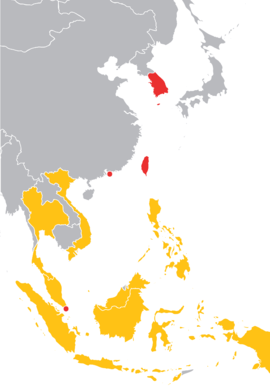Tiger Cub Economies

The term Tiger Cub Economies collectively refers to the economies of Indonesia, Malaysia, the Philippines, Thailand and Vietnam,[1] the five dominant countries in Southeast Asia.[2][3]
Tiger Cub Economies are so named because they follow the same export-driven model of economic development pursued by Hong Kong, Singapore, South Korea and Taiwan, which are collectively referred to as the Four Asian Tigers. Young tigers are referred to as "cubs", the implication being that the five newly industrialized countries[4] who make up the Tiger Cub Economies are rising Tigers. In fact, four countries are included in HSBC's list of top 50 economies in 2050,[5] while Vietnam, Indonesia and the Philippines are included in Goldman Sachs's Next Eleven list of economies because of their rapid growth and large population.
Overseas Chinese entrepreneurs played a prominent role in the development of the region's private sectors. These businesses are part of the larger bamboo network, a network of overseas Chinese businesses operating in the markets of Malaysia, Indonesia, Thailand, Vietnam, and the Philippines that share common family and cultural ties.[6] China's transformation into a major economic power in the 21st century has led to increasing investments in Southeast Asian countries where the bamboo network is present.[7]
Economies of Southeast Asia
Economies of the Tiger Cubs
- Economy of Indonesia
- Economy of Malaysia
- Economy of Philippines
- Economy of Thailand
- Economy of Vietnam
Economies of the Four Asian Tigers
References
- ↑ PAUTASSO, D.; CARDOSO, A. K.. A Nova Ordem Energética Internacional. São Paulo: Escola Superior de Propaganda e Marketing/II Seminário de Iniciação Científica da ESPM – São Paulo: 2013
- ↑ Rod Davies (16 June 2002). "Asian Marketing, Market Research and Economic Capsule Review". Asia Market Research. Retrieved 20 February 2013.
- ↑ HOMLONG, Nathalie; SPRINGLER, Elisabeth. Business-Handbuch Vietnam: Das Vietnamgeschäft erfolgreich managen: Kulturverständnis, Mitarbeiterführung, Recht und Finanzierung. Wiesbaden: Springer Gabler, 2013.
- ↑ "The East Asian Miracle Economic Growth and Public Policy". World Bank. 30 September 1993. Retrieved 20 February 2013.
- ↑ Kevin Voigt (12 January 2012). "World's top economies in 2050 will be...". CNN. Retrieved 20 February 2013.
- ↑ Murray L Weidenbaum (1 January 1996). The Bamboo Network: How Expatriate Chinese Entrepreneurs are Creating a New Economic Superpower in Asia. Martin Kessler Books, Free Press. pp. 4–8. ISBN 978-0-684-82289-1.
- ↑ Quinlan, Joe (November 13, 2007). "Insight: China's capital targets Asia's bamboo network". Financial Times.